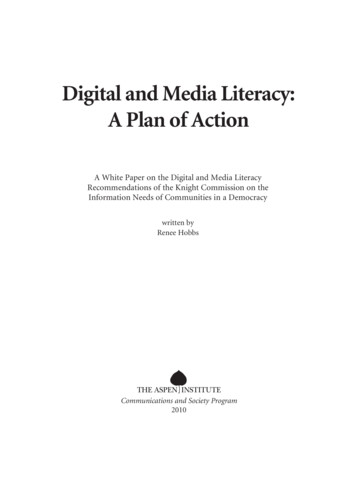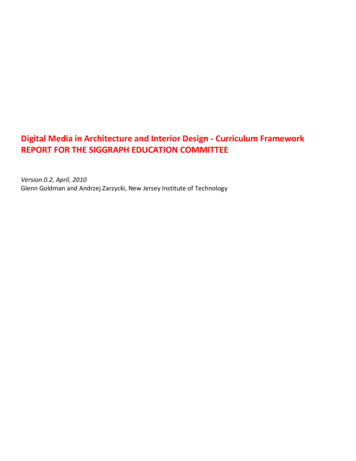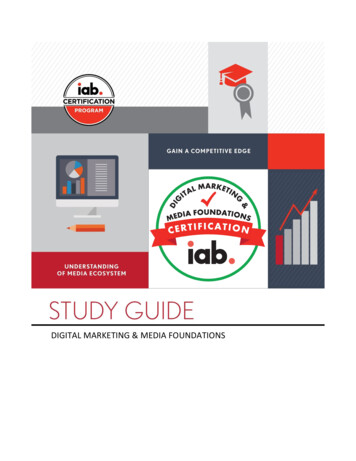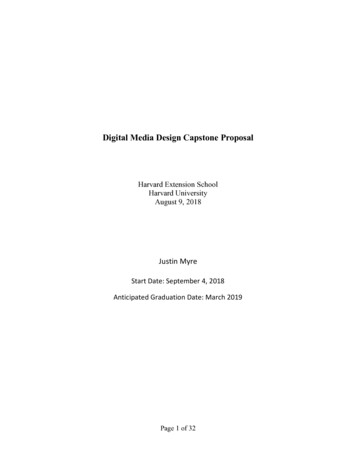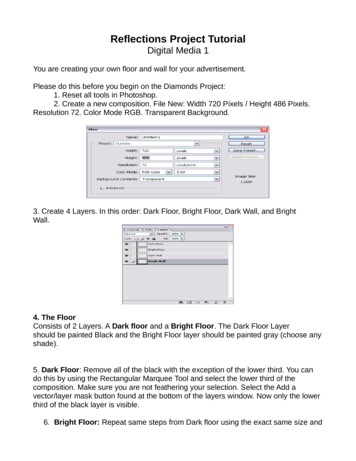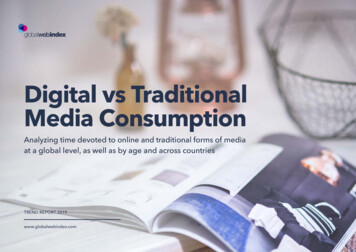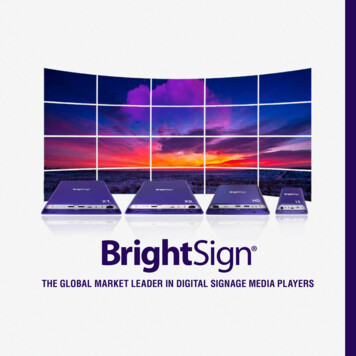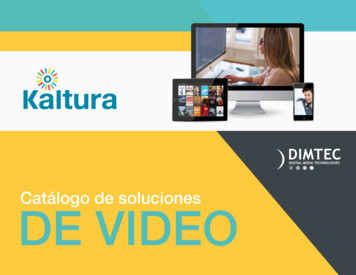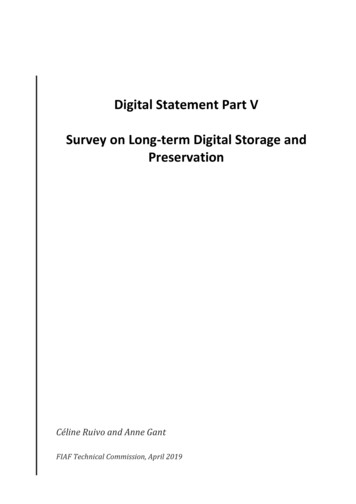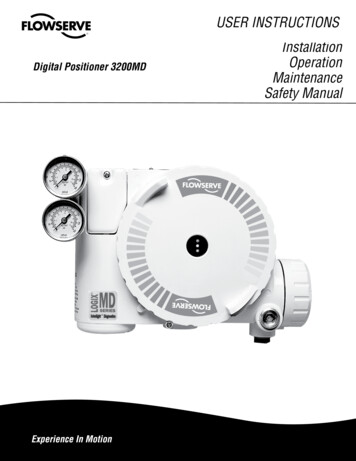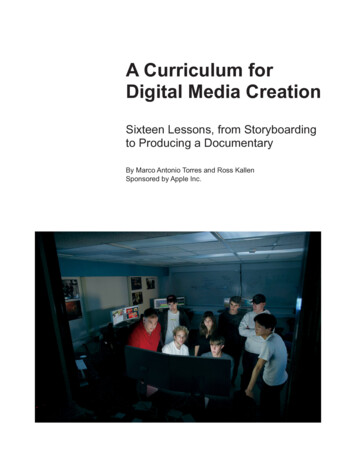
Transcription
A Curriculum forDigital Media CreationSixteen Lessons, from Storyboardingto Producing a DocumentaryBy Marco Antonio Torres and Ross KallenSponsored by Apple Inc.
IntroductionEvery day digital media becomes more important as a means for receiving,producing, sharing, and broadcasting information. Tools and resources that wereonce the exclusive property of a few are now available to many more people.Tomorrow’s publishers, marketing people, and community leaders will need to knowhow to use digital media to persuade others and tell new and effective stories.Knowledge of the rules and grammar of movie production, broadcasting, and mediapresentation is a new powerful literacy.Today’s educators and students will find it particularly valuable to be skilled in theuse of digital media tools such as Final Cut Studio. To help, Apple has created theApple Authorized Training Center for Education program, designed for schools thatuse Apple’s professional software solutions in their curriculum. In addition to usingthe curriculum that the program offers, students have the opportunity to receiveApple’s Pro Certification in Final Cut Studio. This certification communicates tothe world that these students are ready to do professional work on video editingprojects.This curriculum guide is designed as a supplemental resource to the Final CutStudio Certification materials. The 16 lessons included here are linked to eithercontent area standards or skill set competencies and are meant to be taught duringa traditional 18-week semester. This guide also provides the resources to align amoviemaking/editing class to a Regional Occupational Program (ROP) or Perkinsfunded school-to-career program.The authors of this curriculum are Apple Distinguished Educators with extensiveexperience in media production (see “Author Biographies,” next). These are notuntested projects—they are lessons that the authors use in their classrooms toprepare students for leadership in the digital media production and broadcastingfields. Each project includes a list of tools, estimated time required, tips, evaluationsuggestions, additional resources, and more. The “Real-World Connection” sectionin each lesson explains how the skills learned in that lesson will be valuable in thestudents’ professional lives.The 16 projects are the following: Lesson 1: Developing Movie Ideas Lesson 2: From Script to Storyboard Lesson 3: Shoot It! The Production Process Lesson 4: Lighting a Scene and a Person Lesson 5: Working with Audio Lesson 6: Composing Camera Frames Lesson 7: Documentary Movies 101—A Roll and B Roll 2008 Marco Antonio Torres and Ross Kallen. All rights reserved.
A Curriculum for Digital Media CreationSixteen Lessons, from Storyboarding to Producing a Documentary3 Lesson 8: Fix It in Post! Lesson 9: Producing a Music Video Lesson 10: Producing a Documentary Lesson 11: Producing a 30-Second Super Bowl TV Ad Lesson 12: Creating a Cross-Curricular Project Lesson 13: Film Fiction Lesson 14: Budgeting Lesson 15: Filming a Professional-Looking Product Lesson 16: The Show!Author BiographiesMarco Antonio Torres, Teacher, Media Coach, San Fernando High School, LosAngeles Unified School District, CAMarco Torres is an internationally recognized Social Studies teacher in an urbanhigh school in Los Angeles. He is also a professional filmmaker, photographer,designer, keynote speaker, and digital media professional trainer. Torres is an AppleDistinguished Educator and serves on the George Lucas Educational FoundationBoard. The California legislature has recognized him as a California Teacher of theYear. Learning creatively is his passion. In his teaching, Torres combines mediatechnology, content area focus, community building, and student empowerment.He believes in making learning more relevant, meaningful, and applicable with theassistance of today’s new teaching, learning, networking, and creative environmentsand resources. His specialty is documentary-style production and how to plan,manage, execute, and showcase student movie projects.Ross Kallen, Teacher, Digital Media Production, Rancho Bernardo High School,Poway Unified School District, Poway, CAA digital media specialist for over 10 years, Ross Kallen created the Rancho BernardoHigh School Digital Media Arts Program and was recently honored by the NationalAcademy of Television Arts and Sciences with five National Student TelevisionExcellence Awards. He has led professional training seminars in the areas of liveproduction, post-production, and studio design at state and national technologyconferences and seminars. Kallen is an Apple Distinguished Educator and haspresented workshops and seminars at national and international events ranging fromthe National Association of Broadcasters (NAB) convention to the Digital OlympicForum for the Beijing 2008 Olympiad. Many of his graduates have won awards at thelocal, regional, and international level and have been showcased on Apple’s website.Kallen’s media program has also been recognized in Government Video Magazine,and the California legislature selected him as a “High Tech Teacher” in 2000.Setting Up the Classroom StudiosWhen George Lucas made his first epic Star Wars movie in 1977, he had to inventor purchase equipment that was custom-made for his movies. He was then the onlyone who had access to those tools. After a break, Lucas revisited his space sagaand made Episodes I, II, and III with a new set of tools. The digital revolution hadrestructured how he would make these movies. Moreover, the tools his team used 2008 Marco Antonio Torres and Ross Kallen. All rights reserved.
A Curriculum for Digital Media CreationSixteen Lessons, from Storyboarding to Producing a Documentary4for the new movies could now be purchased over the counter, giving moviemakerseverywhere access to the same tools as Industrial Light and Magic. This newdemocratic access to tools and resources once exclusively available to professionalfilmmakers and university film professors has changed how stories are producedand how we, as teachers, teach the art of digital storytelling. This section providesinformation about setting up your classroom studio. It includes information aboutsoftware and equipment students will use in the projects as well as suggestions foradditional post-production equipment that will come in handy.Setting up a studio in your classroom is very similar to setting up a professionalstudio. Thanks to the flexibility of Final Cut Studio, it is not mandatory to purchaseadditional post-production equipment. However, workflow is key in a classroomsetting, and learning how to organize, manage, and distribute movie projects doesrequire additional items to help facilitate the process of production. This chapter offerssuggestions for supportive gear based on what can work for your classroom spaceand budget. Three options are presented for you to choose from:The Ideal Setup: When money is not much of an issue and additional space isavailableThe Great Setup: Excellent for schools that eventually will grow into a more idealsituation, but that need to work up to that pointA Good Setup: Not the ideal, but a good way to begin a production studio and getthe classroom ready for the Apple Certification curriculumTechnology HardwareThe following chart provides detailed recommendations for the Ideal Setup, the GreatSetup, and the Good Setup. All of these options can evolve and expand as budgetsgrow and expand. If students have a camera with microphone inputs, a mic, a goodsense of light (knowing how to use what is natural and available), Final Cut Pro, anda plan—they can create a great movie. The recommendations for additional items canhelp add production value to the movie projects. 2008 Marco Antonio Torres and Ross Kallen. All rights reserved.
A Curriculum for Digital Media CreationSixteen Lessons, from Storyboarding to Producing a Documentary5Make sure all of the gear is labeled and inventoried. You can develop a checkoutform to track all equipment being used by students. It works well to have one or twostudents who are responsible for checking out all equipment, with the requested gearrequiring your approval as the teacher (you have the role of the executive producer—the ultimate money decider). The requested items need to be reflected in the moviebeing shot. In other words, if a movie is shot in the middle of the day, there is no needfor an on camera light. Fill lights can be added via Lightdisks.ComputerCamera& videosupportThe Ideal SetupThe Great SetupThe Good SetupMac Pro, MacBook Pro, or iMac with asmuch storage as possibleMac Pro, MacBook Pro, or iMac with asmuch storage as possibleMac Pro, MacBook Pro, or iMac withas much storage as possibleHD Pro Camcorders3 CCD High-End Camcorders3 CCD Camcorders Panasonic AG-DVX100B Canon GL-2 SONY DCR-VX2100Make sure the cameras youorder have both a mic port and aheadphones jack. Most of today’sconsumer cameras don’t have theseessential ports. Also, cameras thathave a shoe mount make it easier tomount an additional mic, light, and soon.Panasonic AG-HVX200JVC GY-HD11 DUCanon XL-H1Sony HVR Z1U Video deck Video deckHigh-end cameras are not designedto be used as playback machines. Werecommend getting a Sony DSR-11, adedicated and durable playback machinethat can fit on a desktop. Depending onthe size of your program, you may want tobuy one for every capturing station.Note: Not all computers will be used tocapture video. Some will only be used toedit. Also, it’s more expensive to maintaina camera if it’s used as a player andrecorder as well. Try and use it for onefunction—videotaping. The DSR-11 cando the player portion.If you cannot afford a video deck, useanother camera for the deck. Just useit for that purpose alone. You can finddecent and compact cameras for under 600 that can be dedicated video decks.See the discussion about the merits of adedicated video deck in “Ideal Setup.”Video Reference MonitorYou can use any monitor that accepts anS-Video In connection from the cameraor video deck. Ideally, you would wantthe S-Video connection for better picturequality; however, if you only have RCA/Composite In connections, it will work(but will look “fuzzier” or softer).Video Reference MonitorWe have found portable DVDplayers that have RCA/CompositeIn connections. Connect the cameraor the video deck directly into it andyou have a portable video referencemonitor. You may want to get a DVDplayer that has a 16:9 and 4:3 aspectratio switch. This may come in handydepending on how you shoot: wideanamorphic or 16:9 or the more TVstandard of 4:3 (more square looking).Video Reference MonitorAnother essential broadcast tool is anNTSC color reference monitor. Thesemonitors help you see what the project willlook like on TV. Colors from the monitor,titles, and graphics look different on TVthan on a computer screen. A computerscreen looks at images via pixels, or dots;a TV uses lines to display an image. Thisdifference leads to different results. Avideo reference monitor helps you viewa more accurate color representation.Sony and JVC make the best referencemonitors but range in price between 600to 1000. HD reference monitors areavailable as well, but be prepared to pay. 2008 Marco Antonio Torres and Ross Kallen. All rights reserved.
A Curriculum for Digital Media CreationSixteen Lessons, from Storyboarding to Producing a DocumentaryThe Ideal SetupThe Great SetupThe Good SetupShotgun/boom stereo microphone anda wireless UHF lavaliere microphonesystemShotgun/boom stereo microphone anda wireless UHF lavaliere microphonesystemThere are several mics here to choosefrom. Reputable companies for these areSennheiser, Audio Technica, and Azden.(Range: 400 to 1000)Entry-level mics are available. Thesound may not be as “warm” andclear, but it is still way better than whatcomes with the camera. Plus, learningwhat mics to use is a key lesson initself.M-Audio Studiophiles BX8M-Audio Studiophiles BX5M-Audio has education pricing. There aremany options here, but M-Audio has beenvery reliable and its education departmentcan facilitate the dialogue between whatyou want to do and what is best for yourbudget.M-Audio has education pricing. Thereare many options here, but M-Audiohas been very reliable and its educationdepartment can facilitate the dialoguebetween what you want to do and what isbest for your budget.An affordable pair of speakers fromyour local electronics storeSound Shotgun/boom stereo mic and a wirelessUHF lavaliere microphone systemThere are several mics here to choosefrom. Reputable companies for these areSennheiser, Audio Technica, and Azden(with a price range of 400 to 1000).When buying a camera, make sure youhave a microphone port and a headphoneport as well. Buy good headphoneswith good bass. We recommendany headphones over 40. If you’reinterviewing and working the camera,we recommend ear buds, which are lessobvious than the bulky earmuffs. Sure,Ultimate Ear, and V-Moda all make decentear bud headphones.You may want to purchase a boom polewith a shock mount to connect the pole tothe camera. The shock mount suspendsthe microphone to avoid the recordingof microphone movement. Poles canbe purchased for around 100 to 300(better, carbon fiber ones are moreexpensive). Shock mounts usually haveto be purchased separately for 50 to 150. Find one that fits your microphoneproperly.Another helpful item is a windscreen forthe sensitive microphones. They eliminatethe annoying blowing sound that appearsin most family outdoor excursion videos.Speakers6 2008 Marco Antonio Torres and Ross Kallen. All rights reserved.
A Curriculum for Digital Media CreationSixteen Lessons, from Storyboarding to Producing a DocumentaryThe Ideal SetupTripod & Carbon fiber tripod legs and a fluid tripodhead headThe carbon fiber is a light material. Thesetripods will last a long time and are notheavy. We recommend Bogen, Manfrotto,and Gitzo. The fluid tripod heads are veryi
A digital media specialist for over 10 years, Ross Kallen created the Rancho Bernardo High School Digital Media Arts Program and was recently honored by the National . Academy of Television Arts and Sciences with five National Student Television Excellence Awards. He has led professional training seminars in the areas of live production, post-production, and studio design at state and national .

